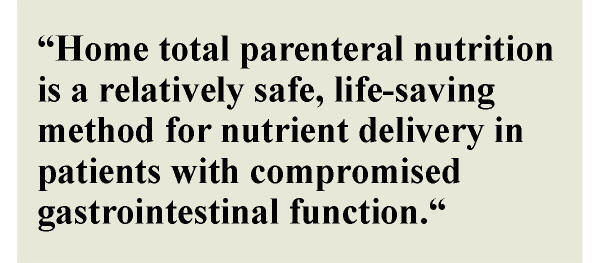 Instructions
Instructions
|
Study 1 Citation: Buchman AL.
Complications of long-term home total parenteral nutrition: their
identification, prevention and treatment. Dig Dis Sci 2001 Jan;46(1):1-18 |
Click on the link at left to go to your desired page: Page 1 Page 2 Page 3 Page 4 Page 5 Post-Test
_files/image001.gif)
Abstract:
 Home
total parenteral nutrition has been associated with many complications over
the years. This review aims to determine if those complications are
attributable to the TPN, or to some other precipitating factors. Manuscripts
and abstracts from the English literature since 1968 were analyzed to
determine what these complications have been. The focus of this review will
be the identification, treatment and prevention of these complications. The
author states that home parenteral nutrition is a safe, life-saving therapy
for nutrient delivery and is particularly useful in patients with
compromised gastrointestinal function. Buchman does note that there are
other complications that can prove difficult to work with, namely related to
the delivery system and gastrointestinal, renal and skeletal systems.
Home
total parenteral nutrition has been associated with many complications over
the years. This review aims to determine if those complications are
attributable to the TPN, or to some other precipitating factors. Manuscripts
and abstracts from the English literature since 1968 were analyzed to
determine what these complications have been. The focus of this review will
be the identification, treatment and prevention of these complications. The
author states that home parenteral nutrition is a safe, life-saving therapy
for nutrient delivery and is particularly useful in patients with
compromised gastrointestinal function. Buchman does note that there are
other complications that can prove difficult to work with, namely related to
the delivery system and gastrointestinal, renal and skeletal systems.
|
Complications of Long-Term TPN Infections |
Total Parenteral Nutrition (TPN), Crohn’s Disease, hyperemesis gravidarum, malabsorption, short bowel syndrome, radiation enteritis
Total parenteral nutrition (TPN) has a long history in the home setting. The first patient was sent home in 1968 on TPN (1), since then the number of patients sent home on this therapy have been approximately 40,000/year (2). While many of these patients require TPN temporarily, due to illnesses such as high-dose chemotherapy, bone marrow transplantation and hyperemesis gravidarum, some patients may require TPN on a permanent basis. These patients are often found to be under the care of an internist for other diseases such as short bowel syndrome, radiation enteritis, malabsorption, and others. It is understood that there are complications associated with TPN, and the medical team should be aware of how to identify them. However, as this review demonstrates, many of these are avoidable.
Included in this study is a listing of the various organisms that cause infections. They fall into one of four groups: gram positive, gram negative, fungi and mycobacteria.
This review article is intended for the practitioner, and it should be noted that additional research is deemed necessary.
Results:
While this review specifically looked at home TPN patients over the past 33 years, common complications were seen within this group. The vast majority of patients requiring home TPN that died, succumbed to their underlying disease as opposed to TPN related complications (2,3). Survival rates are >87% at one year for patients with benign gastrointestinal disorders (91% at one year, 70% at three years, and 63% at five years) (3). Survival figures are >90% for younger patients with Crohn’s Disease. Therapy-related complications occurred approximately once yearly except for patients with AIDS, cancer, hyperemesis gravidarum, where the incidence was three to four times yearly (2,4). Several comlications considered typical included catheter-related infections, catheter sepsis, catheter occlusions, renal and gastrointestinal complications, metabolic bone disease, and hepatic and biliary disease.
Summary of Study 1
| The review author found that patients who required long-term TPN had impressive survival rates as compared to those that received small bowel transplantation. However, both survival and morbidity can be significantly affected by potentially serious complications associated with this therapy. Infectious complications, the most common, are often related to insufficient patient education which usually leads to sub-optimal catheter care. The author concluded that TPN remains a necessary and effective therapy preferred in cases where longer term nutritional intake is jeopardized by illness or injury. But while TPN is a safe, effective and preferred treatment regimen in many cases, ongoing and future investigation would lead to improved quality of care. |
References:
1. Dudrick SJ, Wilmore DW, Vars HM, Rhoads JE: Long-term total parenteral nutrition with growth, development, and positive nitrogen balance. Surgery 64:134-142, 1968.
2. Howard L, Ament M, Fleming CR, Shike M, Steiger E: Current use and clinical outcome of home parenteral and enteral nutrition therapies in the United States. Gastroenterology 109:3355-365, 1995.
3. Messing B, Lemann M, Landais P, Gouttebel MC, Gerard-Boncompain M, Saudin F, Vangossum A, Beau P, Guedon C, Barnoud D, Beliah M, Joyeux H, Bouletreau P, Robert D, Matuchansky C, Levere X, Lerebours E, Carpentier Y, Rambaud JC: Prognosis of patients with nonmalignant chronic intestinal failure receiving long-term home parenteral nutrition. Gastroenterology 108:1005-1010, 1995.
4. Buchman AL. Moukarzel A, Goodson B, Herzog F, Pollack P, Reyen L, Alvarez M, Ament ME, Gornbein J: Catheter-related infections associated with home parenteral nutrition and predictive factors for the need for catheter removal in their treatment. JPEN 18:297-302, 1994.
5. Lyman, Beth: Metabolic Complications Associated with Parenteral Nutrition. Journal of Infusion Nursing 25: 36-44, 2002.

